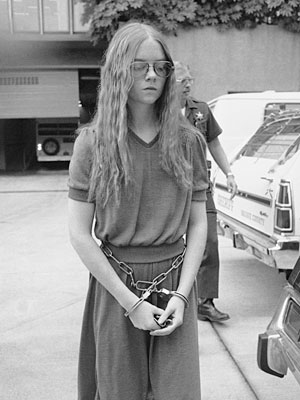“Ugh, it’s Monday” are the words that usually follow the arrival of the most dreaded day of the week. The sighs floating in the air are palpable and nothing seems possible. Mondays always carry with them a negative connotation and contain components such as depression, fatigue, and anguish. But to a San Diego elementary school, and to a troubled sixteen year old, Monday, January 29, 1979 held an even more distressing meaning.

Students at Grover Cleveland Elementary School, located in San Diego, California, began what they believed would be a normal Monday morning like any other, with bells ringing and students racing to their classes. Little did they know, however, that across the street, sixteen-year-old Brenda Ann Spencer was aiming her .22 caliber semiautomatic rifle right at society’s ultimate refuge, the elementary school, and its surroundings. After the first bell rang, Brenda broke the panels on the front door of her home, which was located right across the street from the elementary school. And she began to fire. The school’s principal, Burton Wragg, while rushing outside, was hit on the shoulder and chest with Spencer’s bullets and eventually died. Michael Suchar, the school’s custodian, ran outside with a blanket in order to cover Wragg and keep him from going into shock, but he quickly became the second victim of Spencer’s shooting and lost his life. In between all the chaos, 28 year old Robert Robb, a recent graduate of the police academy, while examining Wragg’s and Suchar’s bodies, was shot under his right shoulder blade.1 He would go on to survive though, along with the eight other children who were wounded in the incident. At least three of those children had abdominal wounds. A nine-year-old student, Cam Miller, was struck in the back with a bullet that exited through his chest without hitting any internal organs. Another, Christy Buell, was shot through her abdomen and in the buttocks, and had to undergo surgery in order to repair her intestine.2
When Gus Stevens, a reporter for the San Diego Evening Tribune, began calling around the area to gain more information about the shooting, he coincidentally placed a call to Spencer’s home where she gave him exactly what he wanted. She described the shooter, a sixteen year old, and the shooter’s address. When Stevens realized that she gave him her own address, he recognized what was going on and requested an interview while another staff member informed the police of the situation. The police, now aware of where the shots were coming from, were able evacuate the children and obstruct Spencer’s line of sight while trying to negotiate with her. After several hours, Brenda Spencer surrendered her weapon and several rounds of ammunition, and was subsequently arrested. While on the phone with Stevens, Spencer had stated that she was just shooting for the “fun of it.” She went on to say that she just didn’t like Mondays and did this “because it’s a way to cheer up the day.”3

Contrary to her initial claim, she later went on to state in her 2001 parole hearing that she had been “sexually abused by [her] father” and was “waiting for the cops to show up so they could shoot [her].”4 This new information has fueled many more theories today about Brenda Spencer’s true motives in committing such a crime. During her pretrial psychological testing, an injury to Spencer’s temporal lobe came to light. Spencer has also stated in a letter from prison that she experiences “grand mal seizures” that she has to counteract with medications.5 Such a brain injury would definitely be a precursor to epilepsy, which is two to four times more common among violent offenders than the public.6 The lack of treatment she received for this disease, to some, proves the neglect that she experienced from her family and in her childhood. Psychologist Jonathan Fast introduces the idea that her brain injury, abuse, and the effects of it pushed her to her final actions. He believes that the shame, ridicule, inferiority, and powerlessness that she felt encouraged her to go as far as she did. In another letter she wrote in prison, she stated that her “father had done everything a person could do to another person. The beatings, the touching, the emotional abuse.” She went on to state that no one, not teachers or counselors, gave her assistance through this, so she simply thought that this was how the world and how life worked. When her father gifted her the .22 caliber rifle, she thought that he was finally telling her to do it: to take her life successfully, unlike her past suicide attempts, and leave the world forever.7
Whether these theories are true or not, Brenda Spencer was tried as an adult and pleaded guilty to two counts of murder and nine counts of assault. She was sentenced to twenty-five years to life in prison, and is still serving her sentence at the California Institute for Women. The shooting has inspired a song by the Boomtown Rats called “I Don’t Like Mondays,” and has also gained other media coverage through a documentary.8 Her action went down in history as the first high profile school shooting and has become a vanguard to many future, unimaginable school situations and violent outbreaks. Whether Spencer was a cold-hearted killer or a truly lost and confused soul that simply wanted an escape, it is undeniable that her horrible actions have had some frightening consequences in our modern world.
- Jonathan Fast, Ceremonial Violence (New York: The Overlook Press, 2008), 25, 70-71. ↵
- Tamara Jones, “Look Back in Sorrow,” Good Housekeeping 227, no.5 (November 1998): 118. ↵
- Jonathan Fast, “Unforgiven and Alone: Brenda Spencer and Secret Shame,” in School Shootings: International Research, Case Studies, And Concepts For Prevention, ed. Nils Böckler (New York: Springer, 2013), 253-255. ↵
- Debra Sevey, “Subsequent Parole Consideration Hearing of Brenda Spencer,” (Capitol Electronic Reporting, 2001), 15-16. ↵
- Jennifer Furio, Letters From Prison: Voices Of Women Murderers (New York: Algora Pub., 2001), 134. ↵
- Jonathan Fast, ” Unforgiven and Alone: Brenda Spencer and Secret Shame,” in School Shootings: International Research, Case Studies, And Concepts For Prevention, ed. Nils Böckler (New York: Springer, 2013), 251. ↵
- Jennifer Furio, Letters From Prison: Voices Of Women Murderers (New York: Algora Pub., 2001), 134-135. ↵
- Encyclopedia of School Crime and Violence, September 2011, s.v. “Brenda Spencer,” by Laura L. Finley. ↵



243 comments
Jazmin Pizana
Very well written and interesting article. I have never heard about this case but it’s sad to see how school shootings have become very common in today’s society. This was a truly tragic story. It was a normal Monday for the kids and faculty in the school and didn’t realize it would be their last days.
Karina Nanez
What an awful thing to do to innocent children just going to school. You were very descriptive in what happened and going into the mindset of Brenda Ann Spencer, the tragedy could have been a greater loss of life had it not been for that reporter that called and distracted her long enough to be found. This was a chilling and interesting article.
Veronica Spryszynski
I see Monday just as another day in the week, I don’t stress the beginning of the week. Brenda has gone too far just because she didn’t like Mondays in her first claim that she did the shooting just for fun. Its awful that people had to lose their lives so young and adults as well, I don’t believe that her claims about abuse provoked that event, but I believe that it did happen.
Zeresh Haman
This is really well written article about a really sad story. It is amazing to me how someone could just open fire at an elementary school, and feel little to no remorse about it after. I truly feel sorry for Spencer, that she couldn’t find a healthy way to express what she was feeling, or deal with everything that had happened to her in her life. I’m a strong believer that no matter what happens in our lives, we can choose to overcome it.
Sarah Mares
Reading this article, unfortunately, brought back many of the tragic shootings (especially in schools) that have taken place since the Cleveland Elementary shooting of January 1979. The article itself was strongly written and was clear in thoroughly explaining the topic, which sadly, did not entirely phase me due to all the horrific and violent incidents that have occurred in the U.S. since Brenda Spencer’s killing spree. Spencer saying that she hated Mondays and wanted a way to cheer up the day is truly terrifying in the sense that it was such a simple motive behind such a complex situation. It is absolutely sick to hear of incidents like this occurring, and to come from fellow human beings, you just have to wonder what exactly corrupts people to take actions like these and think it will solve all their problems and essentially save them.
Rebekah Esquivel
Although this is a very sad and somewhat disturbing story it was a very interesting article. She really did not have a pinpointed reason for shooting at this elementary school at first besides it being Monday so she wanted to brighten up her day. This is one of the first clues to show there was something seriously wrong with this girl. She saw getting the rifle as a way to finally end this horrible life that she felt she was living. No child or any person in general should feel the need to end her life, this was her escape and way of getting out of the nightmare she was possibly living. It is so sad that this was her only method of getting out. Overall I enjoyed reading this article.
Edith De Loera
This article was a very interesting read, despite the horrific topic it was written about. What I enjoyed most about the articles structure is that while the writer stated facts about the event, she also showed a psychological point of view by giving some background into her childhood. I don’t believe anyone will ever understand what goes through people’s minds when they do heartless acts such as this one. It is unfortunate that impulsive shootings are so common nowadays.
Mark Martinez
An extremely well written and put together article. Its generally a scary thought of how someone can snap and do something crazy. Being able to look down a gun pointed at young children, then taking shots. It still can’t wrap my head around someone being able to do that especially at the age of 16. Regardless of what Brenda Spencer went through, if it turned out to be true, she was pushed over the edge and took others with her.
Zeresh Haman
This is a very well written article. I have actually never heard this story before, but it is truly tragic and is in many ways strange. What makes a person wake up and decide to do something like this, no matter what is going on in your life. I truly feel sorry for Spencer, in the sense that she could not think of a better way to express what she was feeling, and deal with everything that had happened to her in her life.
Lauryn Hyde
Very interesting article, it is horrible to hear about school shootings where innocent people, mostly children, were injured or lost their lives. Shooting like this done by Brenda Spencer still happen today and it is heart breaking. I find it interesting how she tried to us her personal life and the fact that she did not like Mondays as an excuse for the unspeakable acts she committed. Overall great article and informative over a shooting I had never heard of before.